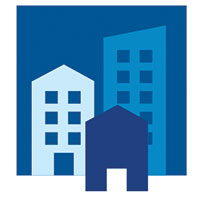Planning Home Case Study: Washington, D.C.
Inclusionary Zoning Implementation Amendment
Community Challenge

Washington, D.C.
Washington, D.C., has had a housing affordability problem for almost two decades. Throughout the 1990s, D.C. home prices and household income grew at the same pace. Beginning in 2000, those chart lines diverged. The District was experiencing a thriving economy marked by high demand for residential and office development, high land costs, demographic shifts, and low interest rates. Household income and wages, however, did not keep pace, and housing quickly became unaffordable for many residents, especially for the low-to-middle and lowest-income households. As in many large cities, most of the affordable and subsidized housing in the District was concentrated in the poorest neighborhoods.
According to the D.C. Office of Revenue Analysis, by 2006, the District's median home price had risen from $198,550 to $447,850 (a 125.6 percent increase), while median family income (MFI) grew only 34.5 percent. Rents also rose sharply during that same period, by as much as 12 percent per year.
The D.C. Office of Planning (OP) and the Zoning Commission began work in 2005 to conceptualize and draft an inclusionary zoning (IZ) program. That effort coincided with the adoption by the District Council (i.e., the city council) in 2006 of the Comprehensive Plan. The plan's housing element furthered the goal of both increasing the quantity of affordable housing units and expanding the geographic distribution of affordable housing across the city.
Planning Solution
The Inclusionary Zoning Implementation Amendment Act went into effect in 2006 and regulations implementing it took effect in 2009. The IZ program advanced the city's affordability initiatives by requiring affordable units and market-rate units within the same development to ensure they'd be dispersed throughout the District, including in high-income neighborhoods:
The IZ regulations established four primary goals:
- Create mixed-income neighborhoods.
- Produce affordable housing for a diverse labor force.
- Reduce the burden of housing costs on low- and moderate-income households by keeping housing units affordable over the long term.
- Increase homeownership opportunities for households in the 50 percent and 80 percent median family income ranges.
Polly Donaldson, the director of the DC Department of Housing and Community Development (DHCD), says: "D.C. Mayor Muriel Bowser is committed to producing and preserving more affordable housing for District residents by using a variety of tools, and that includes IZ. This program allows us to produce moderate levels of affordable housing in high cost areas of the city, near good schools, public transportation, jobs, restaurants, and grocery stores."

One Five (1500 Pennsylvania Ave. SE in Ward 6) offers five IZ units and 36 market units. Photo courtesy DHCD.
The IZ program requires most residential developments with 10 or more new dwelling units (or proposed additions to an existing development that would create 10 or more dwelling units) to include a percentage of affordable units (approximately 8 percent to 10 percent of the gross residential floor area) in the same building. In exchange, the developer may receive a density bonus of up to 20 percent of the gross floor area beyond what is allowed under existing zoning regulations. Developers are also eligible for dimensional adjustments to the building envelope to maximize the available density bonus. Adjustments can be made to reduce the required lot width, increase lot occupancy (i.e., lot coverage), and increase building height. The program requires the exterior design, materials, and finishes of all inclusionary units to be comparable to market-rate units. Interior finishes, including appliances, do not have to be identical to the market rate units but must be durable and of good quality.
Prospective renters and buyers of the units can access program information through the IZ Dashboard, a web portal hosted on the DHCD website. There is a map-based search tool with pins at locations of all completed and in-the-pipeline projects. It is similar in appearance and function to a real estate search engine such as Zillow.com. A schedule of maximum income, rent, and purchase prices is also accessible through the dashboard.
Current Results
Each year, as required by the statute, the mayor prepares an annual report of the IZ program. The 2017 Annual Report noted that 124, 191, and 192 inclusionary units had been constructed in fiscal years 2015, 2016, and 2017, respectively. According to Gene Bulmash, the Inclusionary Zoning program manager at DHCD, "IZ took a while to hit its groove, but it's improved over the years and the development community has come to accept it; we're now hoping to produce about 200 units per year."
District planners, DHCD, and the zoning commission made several significant changes to the IZ regulations in 2017. According to Bulmash, "The revised regulations streamlined the process for staff, developers and applicants, continuing to improve the program." They included lowering the required minimum household size for three- and four-bedroom units and removing the maximum household size altogether. The new rules also allow some households whose income has increased since their initial lease was signed to stay in the units.

The Flats of Ivy City (1871 Corcoran Street NW, Ward 5) has one IZ and nine market units available for purchase. Photo courtesy DHCD.

